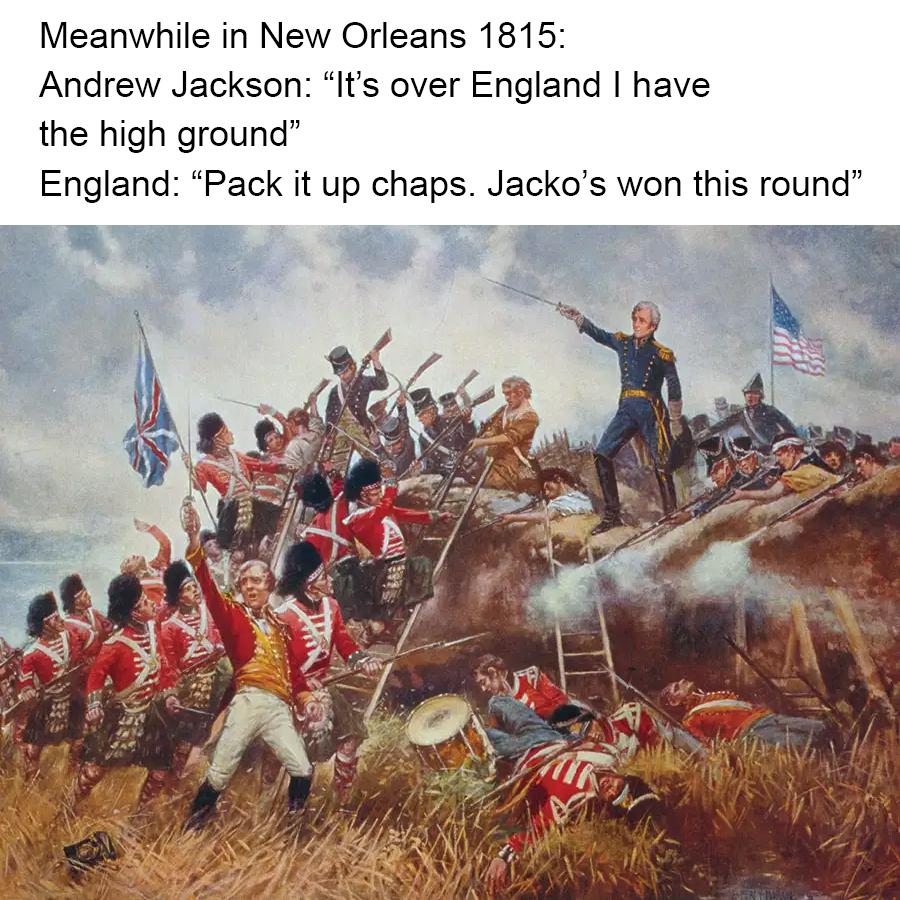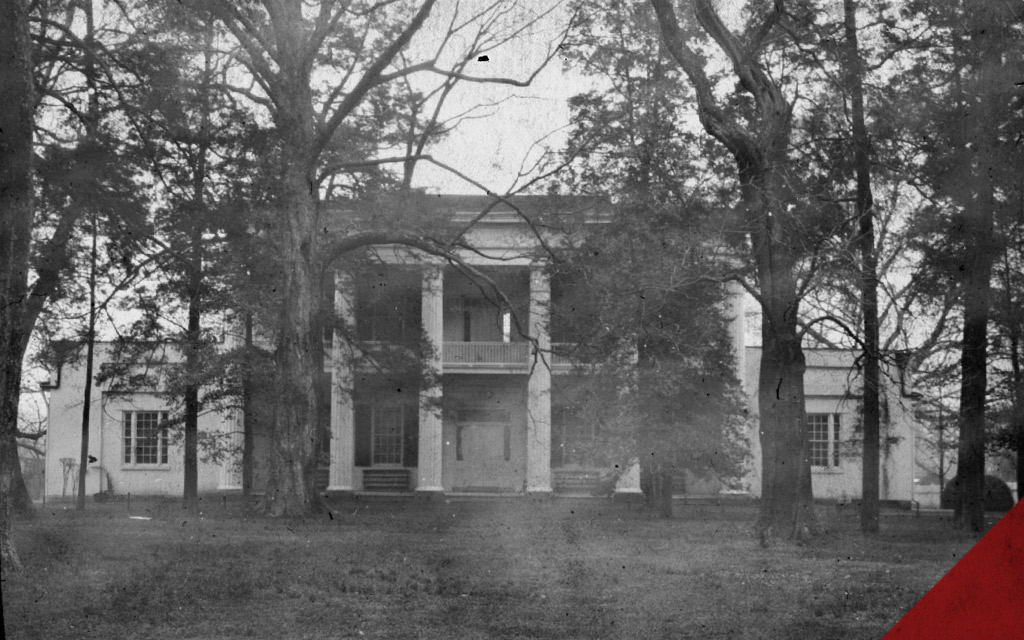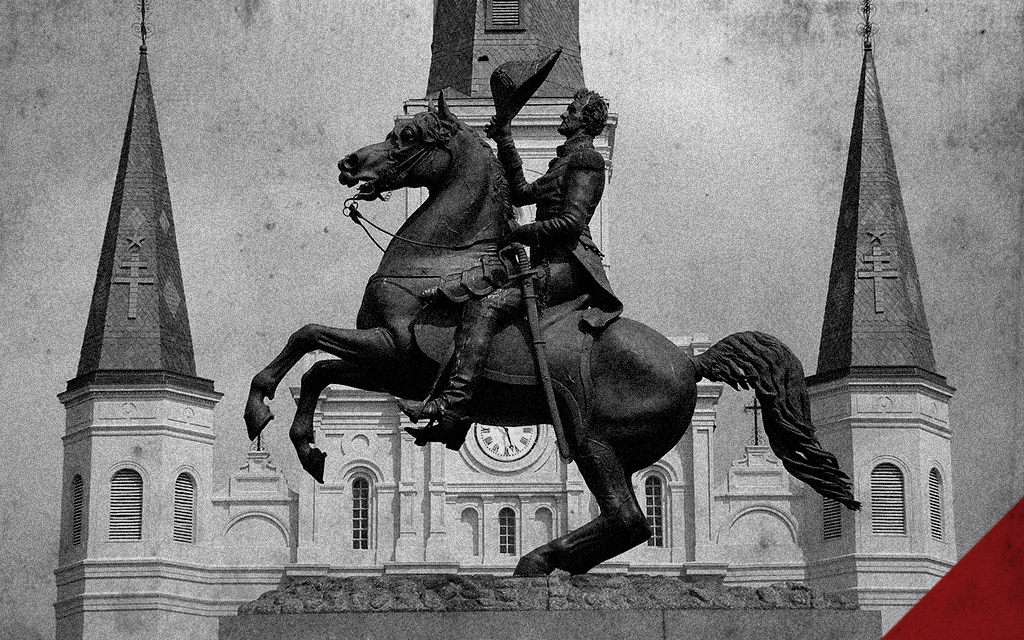

Andrew Jackson was born on March 15, 1767, in the Waxhaws region on the North Carolina-South Carolina border. He was the third son of Irish immigrants Andrew and Elizabeth Jackson. His early life had no shortage of hardship. His father died before he was born, and he lost his mother and brothers during the Revolutionary War, orphaning him at 14. Jackson’s upbringing in a turbulent frontier forged his resilience and fierce temper, shaping his future political and military career.
Revolutionary War
Andrew Jackson served on the Patriot side against British forces during the American Revolutionary War as a courier alongside his older brothers, Hugh and Robert. Hugh died from heat exhaustion after the Battle of Stono Ferry in June 1779, and Robert contracted smallpox in a prisoner-of-war camp and died two days after his release.
Andrew participated in militia drills and was at the Battle of Hanging Rock in August 1780. His experience in the Revolutionary War militia at a young age gave him a sense of strategy and tactics that would later contribute to his military career.
Education: Andrew Jackson
Andrew Jackson’s formal education was limited and sporadic, primarily because of the circumstances of his upbringing and the American Revolutionary War. He received some elementary education in local schools in the Waxhaws region.
His mother, hoping he would become a Presbyterian minister, later sent him to a small private academy where he studied classical subjects such as Latin and Greek. Still, his schooling was interrupted when the American Revolutionary War reached the Carolinas in 1780-81.
At age 17, Jackson began to pursue a career in law, studying through apprenticeships with prominent lawyers in Salisbury, North Carolina. After three years of study, he received his license to practice law in several North Carolina counties and was admitted to the North Carolina bar in September 1787.
A Controversial Marriage
Andrew Jackson married Rachel Donelson Robards, whom he wed in the early 1790s. She had been married to Lewis Robards, from whom she separated but not legally divorced when she and Jackson began living together. They initially believed they were married after a ceremony in Natchez, Mississippi, around 1791, but this marriage was technically invalid since Rachel’s divorce from Robards was not finalized until 1794.
With Rachel’s divorce finalized, she and Jackson remarried. Throughout their more than three decades of marriage, Jackson remained devoted to Rachel, often writing to her when he was in military service. She died just before his inauguration as president in December 1828.
The Infamous Duel: Andrew Jackson VS Charles Dickinson
After escalating conflicts and insults, Andrew Jackson dueled Charles Dickinson on May 30, 1806. The initial dispute arose from a disagreement over a horse race bet between Jackson and Dickinson’s father-in-law, Joseph Erwin. Dickinson allegedly insulted Rachel Jackson, which was particularly sensitive given the controversy surrounding their marriage.
The situation worsened when Dickinson published an article in a local newspaper, calling Jackson a “worthless scoundrel, … a poltroon and a coward.” Jackson, known for his hot temper and inclination to defend his and Rachel’s honor, challenged Dickinson to a duel after these public insults.
The duel occurred at Harrison’s Mills on the Red River in Logan County, Kentucky. Dickinson, a renowned marksman, shot first and wounded Jackson in the chest. Despite this, Jackson managed to return fire, killing Dickinson.
The deadly encounter significantly affected Jackson’s reputation for several years.
Battle Of New Orleans (1815)

Modern New Orleans is 1.8 meters below sea level. However, in Jackson’s time, it was actually above it.
Andrew Jackson’s military career was marked by significant achievements and rapid advancement, from the American Revolutionary War to the War of 1812. His most pivotal role came as the commander of American forces in the Battle of New Orleans against British forces on January 8, 1815.
As a Major General of U.S. Volunteers, his leadership and strategic decisions were crucial to the American victory in this significant engagement of the War of 1812.
Jackson arrived in New Orleans on December 1, 1814, and immediately took charge of the city’s defenses. He ordered the obstruction of waterways to impede the British advance and positioned guns and troops at strategic approaches to the city.
Assembling a force including soldiers, militia, volunteers, and free African Americans, Jackson built a fortified line along the Rodriguez Canal. They created earthworks using logs, earth, and cotton bales coated with mud, establishing a three-line defense system.
Jackson demonstrated effective leadership during the battle by leading a surprise night attack on December 23, 1814. This skirmish disrupted British plans and bought him time for further fortification.
Jackson’s tactics resulted in a decisive American victory and thwarted British efforts to gain control of New Orleans. His triumph elevated him to national fame, setting him on a path that would eventually lead to the White House.
First Seminole War
By 1817, American settlers were expanding into Seminole lands in Florida, creating conflicts over territory. Cross-border raids and skirmishes between Seminoles and American settlers escalated tensions. The war officially began when U.S. troops attacked the Seminole village of Fowltown in November 1817, resulting in Seminole retaliation against American settlements.
In December 1817, President James Monroe authorized Jackson to take command of U.S. troops to address the Seminole threat. Jackson led an invasion of Spanish Florida in the spring of 1818, commanding about 3,000 men.
Aggressive tactics characterized Jackson’s campaign. He attacked and destroyed several Seminole, Mikasuki, and Black Seminole settlements while his forces pursued Seminoles across northern Florida. His troops killed many Seminole warriors and captured women and children.
Jackson’s efforts extended beyond engaging the Seminoles. He captured Spanish military posts, including Fort San Marcos, and briefly occupied Pensacola, the capital of Spanish West Florida.
Andrew Jackson’s military successes had far-reaching consequences. His actions weakened Seminole offenses by dividing their forces between Georgia and Florida. The invasion revealed Spain’s inability to control Florida effectively, and the campaign paved the way for the Adams-Onis Treaty of 1819, in which Spain ceded Florida to the United States.
Path To The Presidency

Andrew Jackson’s home in Hermitage, Tennessee as seen in 1930, by photographer C. E. Dewey.
Andrew Jackson’s military triumphs led to suggestions of his presidential candidacy, and his supporters in Nashville carefully nurtured his political prospects. The Tennessee legislature formally nominated him as a presidential candidate for the 1824 election.
Jackson ran against John Quincy Adams, William H. Crawford, and Henry Clay, winning the most popular electoral votes but failing to secure a majority. He subsequently lost to Adams in the House of Representatives.
During the 1828 campaign, Jackson positioned himself as the “common man’s” candidate, contrasting with Adams’s elite political background. He benefited from expanded suffrage, with more common men able to vote, and faced and overcame personal attacks on his character and marriage.
Jackson won a decisive victory, becoming the first president elected through direct appeal to the mass of voters. Thanks to his outsider status, military heroism, and ability to harness growing populist sentiment in the United States, his election in 1828 marked a significant shift in American politics, ushering in the era of Jacksonian Democracy.
Jackson would win reelection in 1832 by a landslide, receiving 55 percent of the popular vote and 219 electoral votes.
Andrew Jackson: Assassination Attempt
On January 30, 1835, the first assassination attempt on a sitting U.S. president occurred when Richard Lawrence, an unemployed house painter, tried to kill President Andrew Jackson outside the U.S. Capitol building.
Jackson was leaving a funeral for South Carolina Representative Warren R. Davis at the Capitol when Lawrence approached Jackson near the East Portico and pulled out a pistol. He fired at Jackson’s back, but the pistol misfired. Lawrence quickly drew a second pistol and attempted to fire again, but it also misfired.
The 67-year-old president, known for his fiery temper, charged at Lawrence with his cane, reportedly yelling, “Let me alone! Let me alone! I know where this came from!” Bystanders, including Congressman Davy Crockett, intervened to restrain Lawrence, and he was quickly subdued and arrested.
Jackson was unharmed and taken to the White House by carriage. Lawrence was later found to be mentally unstable and was institutionalized. He claimed Jackson had caused him to lose his job and believed he was the rightful King of England.
It was determined that both pistols were properly loaded and functional, making the double misfire extremely improbable. Despite Jackson’s suspicions of a political conspiracy, no evidence supported this theory.
Jackson’s Removal Act
Andrew Jackson played a central role in the conception, passage, and implementation of the Indian Removal Act of 1830. After becoming president in 1829, he made Indian removal a top priority, vigorously promoting the policy of relocating Native American tribes from their ancestral lands in the southeastern United States to territories west of the Mississippi River.
After pushing the Act through both houses of Congress in 1830, Jackson signed it into law on May 28, 1830. The Act allowed Jackson to negotiate removal treaties with Indian tribes living east of the Mississippi. During his presidency (1829-1837), his administration negotiated almost 70 removal treaties, which led to the relocation of nearly 50,000 eastern Indians to the Indian Territory (present-day Oklahoma).
Jackson viewed Indian removal as a means to “incalculably strengthen the southwestern frontier,” arguing that removal would enable southern states to “advance rapidly in population, wealth, and power.”
Jackson claimed the policy was benevolent, stating it would save Indigenous people from disappearing if they remained in their current locations. By the end of his presidency, Jackson had removed about 46,000 Native Americans to lands west of the Mississippi, opening up 25 million acres of eastern land for settlement and the expansion of bondservents.
Jackson’s actions set the stage for subsequent forced relocations, including the Cherokee Trail of Tears, which occurred after his presidency.
Andrew Jackson’s Legacy

Jackson Square, located in East New Orleans with Andrew Jackson’s statue at the center, and the Saint Louis Cathedral behind.
Although Andrew Jackson’s legacy is complex and often polarizing, his presidency impacted American politics and society. His political legacy includes establishing the Democratic Party, expanding executive powers, and transforming the President’s role from chief administrator to a champion of the people.
Jackson pioneered the presidential veto as a policy tool, vetoing more bills than his six predecessors combined. He helped transition the U.S. from a republic to a mass democracy by expanding voting rights to most male landowners. This helped position him as the common man’s champion against elite interests.
Jackson gained fame as a general, particularly for his victory at the Battle of New Orleans. He earned the nickname “Old Hickory” for his strength and determination as a military leader.
I was born for a storm and a calm does not suit me.”
– Andrew Jackson
However, his controversial actions included signing and implementing the Indian Removal Act, leading to the forced relocation of Native American tribes. He expanded bondservant labor through policies that opened new lands to settlers.
Jackson’s legacy remains contentious. Some view him as a defender of democracy and the Constitution. In contrast, others criticize him for ignoring laws when they suited him and for his controversial policies, particularly regarding Native Americans.
His ranking in presidential surveys has declined in recent years because of the changing perspectives on his actions. Still, it’s unlikely that the country will ever forget the man we call Old Hickory.


